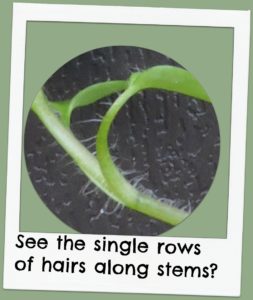Name: Chickweed, Common
Botanical Name: Stellaria media
Form: wildflower
Parts Used: seeds and greens
Citation: Guenther, K. (2017, January 12) Common chickweed as wildlife food [Web log post.] Retrieved: readers supply the date, from http://wildfoods4wildlife.com
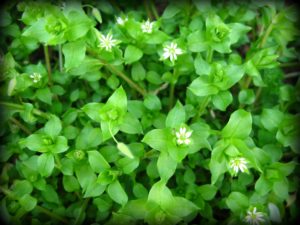
Getting Started
Chickweed seems a happy plant, abundant and cheerful. Though common chickweed is known to be invasive, the upside is you can harvest it in great quantity with impunity! Almost all sparrows in the east like the seed and some birds will pick at the greens as well. It ranks extremely high on our Great Greens list—#3! This is a great wild salad green for cottontails. Chickweed ranks 28th of our Super Seeds list– a solid sparrow seed– as well as seed for many other birds.
Caryophyllaceae (Pink Family)
Stellaria (Starwort Genus)
Many of the other Virginia Stellaria species are commonly known as starworts. Plants from this family often contain saponins which can stimulate digestion and be mildly anti-inflammatory (Elpel, 2013).
| Common name | Virginia Stellaria species | Origin | Rare Plant Status |
| Bog chickweed | S. alsine | native | Globally appears secure and common, but is at highest risk in Virginia |
| Tennessee starwort | S. corei | native | Globally appears secure, but vulnerable in Virginia |
| longleaf starwort | S. longifolia | native | yes, in some states (not Virginia) |
| lesser chickweed | S. pallida | non-native | not rare |
| star chickweed | S. pubera | native | yes, in some states (not Virginia) |
| grass-like starwort | S. graminea | non-native | not rare |
| common chickweed | S. media | non-native | not rare |

Key Features to Look For
In addition to the identification guide of your choice, here are a couple of features you should see on this common chickweed:
- A line of very small hairs running down the stem, use a hand lens to see
- Clear sap, not milky or sticky
- Paired, opposite leaves
- Small white flowers with petals cleft so deeply they look like two petals instead of one
- Low, ankle-high mats of dense greens
About this Species
This is one of the staple greens I harvest every year in great quantities and it can be offered to so many animals in green or seed form. Common chickweed grows often in dense mats low to the ground in flowerbeds or disturbed soils. One can quickly and easily grab up large handfuls of this green herb when it grows thickly. Chickweed produces a lot of seed considering its small size and self sows readily for next year’s crop. It has a funny growing schedule—the seeds germinate and grow towards late summer, the plant overwinters, then has an early flowering and early seed production in spring. So I get a lot of greens in spring and again (less) in fall. In mild winters, I can harvest some greens through winter. And since it goes to seed early, it is one of the earliest seeds I harvest.
Flower Description: Very small, white flowers. If you remove one flower petal and look closely, you will see the flower petal is cleft so deeply that it looks like two petals instead of one.
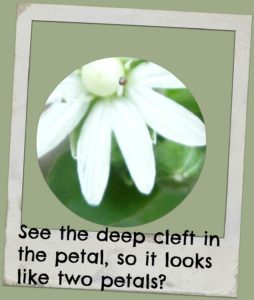
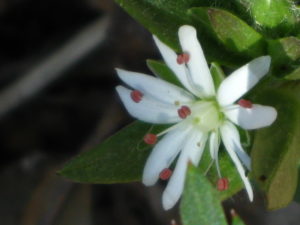
Leaf Description: Leaves are paired across from each other, leaf is about the size of your pinkie fingernail. A line of a few very fine hairs can be seen with a hand lens where the leaf stem (petiole) meets the plant stalk running along one side of the stalk. Leaf is spade-shaped with a pointy little tip.
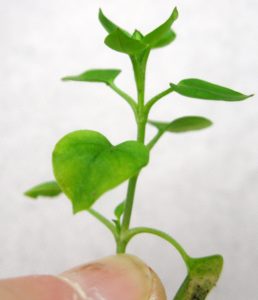
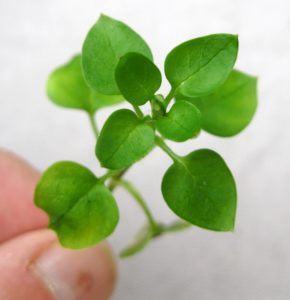
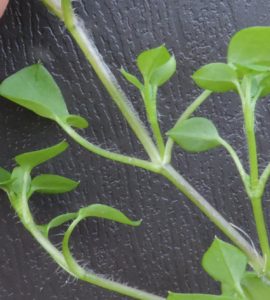
Seed/ Fruit Size: Tiny seeds are 3/32 inch (1 mm) diameter and roundish like tiny pebbles and a reddish-brown color.
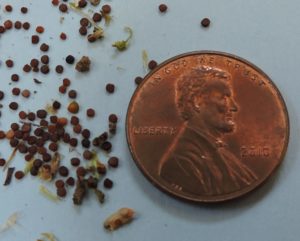
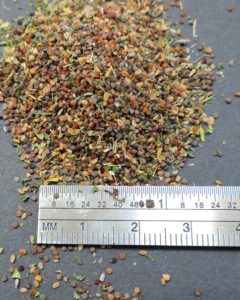
Harvest
| Jan | Feb | Mar | Apr | May | Jun | Jul | Aug | Sep | Oct | Nov | Dec | ||||||||||||||
|---|---|---|---|---|---|---|---|---|---|---|---|---|---|---|---|---|---|---|---|---|---|---|---|---|---|
| winter | winter | late winter | early spring | spring | late spring | early summer | summer | late summer | early fall | fall | late fall | ||||||||||||||
| seeds | x | x | x | x | |||||||||||||||||||||
| greens | x | x | x | x | x | x | x | x | x | x | x | x | x | x | |||||||||||
Is this a good enrichment item? Perhaps. You can try growing your own chickweed from seed in pots and add the potted live plants into enclosures. But then someone will have to keep the pots watered. And, be mindful, that if the plant flowers and goes to seed, you could be introducing this moderately invasive plant into the area.
When to Harvest Chickweed Greens: Greens can be harvested in spring, even as early as mid-March, and again to a lesser extent in fall, even occasionally in winter as chickweed thrives in cooler weather in Virginia. Pull whole plants up at any time when the plant is thick—no need to cut with scissors as this is a shallow rooted plant which will stay fresher longer with roots cleaned but attached.
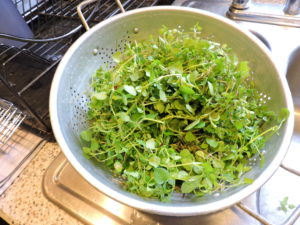
How to Store Prepared Greens: If you choose to, use a commercial vegetable cleaner or a ¼ cup (60 ml) of vinegar added to wash water as a cleaner. Submerge the plant material and swish it around to remove all dirt from leaves and roots. Rinse in clean water. Always wash greens; you never know what might be on them…like animal feces or urine. Place in a colander or salad spinner to drain, then layout a towel and spread the greens on the towel and roll up the towel. Unroll and transfer the damp greens to storage.
For storage, there are a couple of different possible container methods. If the greens will be used quickly within days, place the spun-and-towel-rolled damp greens to a 1 gallon zip-lock baggie with 12-15 holes cut in it to provide air and keep the greens from molding (or reuse commercial grape bags with holes). Label the bag with the plant name and which animals it should be used for. Keep container in the vegetable drawer of the refrigerator.
For storage longer than one week, use a rigid, lidded, airtight container. After washing and salad spinning the greens, place a paper towel in the bottom, then loosely fill with greens, but do not pack them in. Then lay a paper towel on top and put on lid. Keep container in the vegetable drawer of the refrigerator. Do not use if greens become moldy, slimy or dried out.
Many greens are very sensitive to exposure to ethylene gas, though greens themselves are low emitters of the gas. You may get longer quality by adding with a product that reduces free ethylene gas in the refrigerator. Greens are good until they become dry and crispy, fade in color, or become slimy or moldy.
Read more about storing leafy greens under “Harvest, Cleaning and Storage.
How to Harvest Chickweed Seed: Flowers will bloom in stages on the plant, but once heartily in bloom, take note. In a week or do, the plant color will start to fade to a lighter green and the plant will get more leggy, the parts closest to the ground turning yellow/tan. The flowers will develop into little urn-shaped pods with small hairs. This is the ovary swelling and if you dig around in the pod, you’ll find the seeds developing. At this stage, pull up the whole plant and place in a paper bag to dry. As it wilts, then dries over the following month, the tiny seeds will cure and drop out and collect at the bottom of the bag. Periodically shake and toss the dried greens to release as many seeds as possible. Don’t pack the greens in too tightly or they will not dry and will mold. I often harvest 5-6 large paper grocery sacks full of greens to supply a years’ worth of seed.
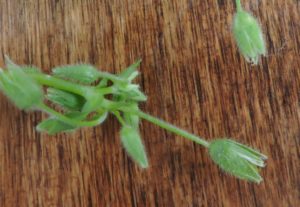
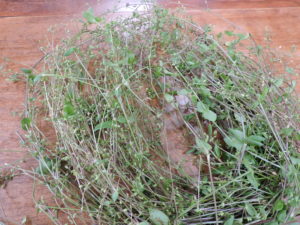
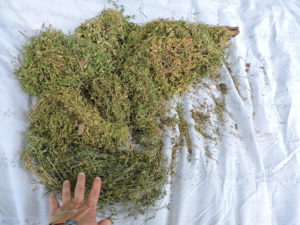
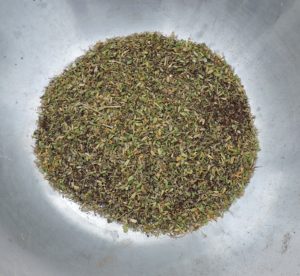
How to Store Prepared Seed: Once cleaned and fully dried, choose a low humidity day—not a rainy day—to jar up your seed.
Glass or metal works best, because all plastics are somewhat porous to humidity. Canning jars and lids work well. Place seed in a tightly sealed, glass container and store in a dark, cool area for up to 1 year. Refrigeration and freezing work well. Label the airtight container with the seed name, date of harvest and which animals it should be used for.
If you intend to keep the seed longer than one year, jar up the seeds in two stages. First, jar the seeds up using a desiccant for up to 1 week. Then check the seed for dryness, and if dry enough, remove the desiccant and immediately repack the seed into an airtight container. Read more about drying seeds and using desiccants under the tab “Food Harvest, Process and Storage.”
Keep stored seed in an airtight glass or metal container in a cool, dark place. Refrigeration and freezing works well, but allow container to warm to room temperature before opening. Discard any seed that ever appears moldy.
Rare Species in Virginia
| County in Virginia | Species | Alert |
| Botetourt | Tennessee starwort | Globally appears secure, but vulnerable in Virginia |
| Pulaski | Tennessee starwort | Globally appears secure, but vulnerable in Virginia |
| Russell | Tennessee starwort | Globally appears secure, but vulnerable in Virginia |
| Scott | Tennessee starwort | Globally appears secure, but vulnerable in Virginia |
| Smith | Tennessee starwort | Globally appears secure, but vulnerable in Virginia |
| Washington | Tennessee starwort | Globally appears secure, but vulnerable in Virginia |
| Fairfax | bog chickweed | Globally appears secure and common, but is at highest risk in Virginia |
Feed chickweed to:
chickweed, common | (Stellaria media) | greens |
|---|---|---|
Beaver, American | Castor canadensis |
|
Cottontail, Eastern | Sylvilagus floridanus |
|
Dickcissel | Spiza americana |
|
Goldfinch, American | Carduelis tristis |
|
Junco, Dark-eyed | Junco hyemalis |
|
Pipit, American | Anthus rubescens |
|
Siskin, Pine | Carduelis pinus |
|
Sparrow, American Tree | Spizella arborea |
|
Sparrow, Fox | Passerella iliaca |
|
Sparrow, Grasshopper | Ammodramus savannarum |
|
Sparrow, Henslow's | Ammodramus henslowii |
|
Sparrow, Lincoln's | Melospiza lincolnii |
|
Sparrow, Savannah | Passerculus sandwichensis |
|
Sparrow, Song | Melospiza melodia |
|
Sparrow, Vesper | Pooecetes gramineus |
|
Sparrow, White-crowned | Zonotrichia leucophrys |
|
Sparrow, White-throated | Zonotrichia albicollis |
|
Towhee, Eastern | Pipilo erythrophthalmus |
|
Bobwhite, Northern | Colinus virginianus |
|
chickweed, common | (Stellaria media) | seeds |
Chipmunk, Eastern | Tamias striatus |
|
Dickcissel | Spiza americana |
|
Dove, Ground | Columbina passerina |
|
Dove, Mourning | Zenaida macroura |
|
Finch, House | Carpodacus mexicanus |
|
Goldfinch, American | Carduelis tristis |
|
Junco, Dark-eyed | Junco hyemalis |
|
Lark, Horned | Eremophila alpestris |
|
Pipit, American | Anthus rubescens |
|
Siskin, Pine | Carduelis pinus |
|
Sparrow, American Tree | Spizella arborea |
|
Sparrow, Chipping | Spizella passerina |
|
Sparrow, Field | Spizella pusilla |
|
Sparrow, Fox | Passerella iliaca |
|
Sparrow, House | Passer domesticus |
|
Sparrow, Lincoln's | Melospiza lincolnii |
|
Sparrow, Savannah | Passerculus sandwichensis |
|
Sparrow, Song | Melospiza melodia |
|
Sparrow, White-crowned | Zonotrichia leucophrys |
|
Sparrow, White-throated | Zonotrichia albicollis |
|
Towhee, Eastern | Pipilo erythrophthalmus |
|
Bobwhite, Northern | Colinus virginianus |
|
Book references:
Elpel, T.J. (2013) Botany in a Day (APG). Pony, Montana: Hops Press, LLC.
Martin, A.C., Zim, H.S., Nelson, A.L. (1951). American Wildlife and Plants: A Guide to Wildlife Food Habits. New York: Dover Publications.
Scott, M. (2013). Songbird Diet Index. National Wildlife Rehabilitators Association, St. Cloud, MN.
Townsend, J. F. (2015, April) Rare Plants Natural Heritage Technical Report 15-10. (Unpublished Report) Richmond, Virginia: Virginia Department of Conservation and Recreation, Division of Natural Heritage.
On-line references:
USDA, NRCS. 2015. The PLANTS Database (http://plants.usda.gov, 4 January 2016). National Plant Data Team, Greensboro, NC 27401-4901 USA.
Virginia Botanical Associates. (Accessed January 2016). Digital Atlas of the Virginia Flora (http://www.vaplantatlas.org). c/o Virginia Botanical Associates, Blacksburg.

